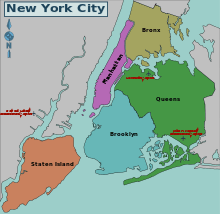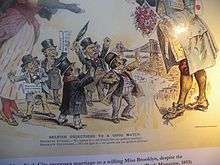City of Greater New York

The City of Greater New York was the term used by many politicians and scholars for the expanded City of New York created on January 1, 1898 by consolidating the existing City of New York with the East Bronx, Brooklyn, most of Queens County, and Staten Island.[1][2] The section of the Bronx west of the Bronx River had been annexed to the City and County of New York in 1874, and was known as the Annexed District.[3] In the years leading up to consolidation, the City of Brooklyn had expanded by annexing all of the other towns and cities in Kings County. Only the western part of Queens County was part of the consolidation plan.[4] In 1899, its three eastern towns separated to form the new Nassau County.[5]
History
While remaining a county in relation to the state, each county became a borough within the City, with the Bronx reunited to form a fifth borough that shared New York County with Manhattan. A separate Bronx County was established in 1914 (see History of the Bronx#Before 1914), making the present New York County co-extensive with the Borough of Manhattan.
The term City of Greater New York was never a legal or official designation as both the original charter of 1898 and the newer one of 1938 use the name of City of New York.[3] It is still used in modern-day books relating or including the time period when the consolidation took place.[6]
Since the late 1820s there had been some discussion of a unified city, with the New York State legislature voting in 1857 that the region surrounding New-York City should become one more efficient body.[7] In the beginning it already wasn’t the people but the State Legislature in New York that attempted to unify the city. They attempted to do so by government vote, in order to improve harbor facilities and link the systems of trade, but distrust of large projects killed the plans.[8] The consolidation movement was the work of politicians both local, city, and state, most prominently the president of the "Greater New-York Commission"[9] and "The Father of Greater New York"[10] Andrew Haswell Green. He, as it so happened, was at the time also a member and greatly involved “Member of the Board of Commissioners of Central Park” which provided him a platform to push his views.[11] The next real challenge to the independence of the boroughs was a self-promoted and government appointed commission. The commission led the “Vote for Greater New York" movement and was the force behind its coming to fruition.[9] Some opponents derided the effort as "Andy Green's hobby", but eventually they were proven wrong.[12] The center of the plan was the consolidation of the twin cities of New York and Brooklyn, whose fire departments had been merged into a Metropolitan Fire District in 1865.[13] The addition of Long Island City and various rural areas anticipated future development of those areas. With Republicans historically more powerful in Brooklyn and Democrats elsewhere, partisan politics played a role, each major political party hoping to dominate the consolidated city.

The plan required a referendum in all affected areas, though the organizers of the referendum clearly had a bias towards the consolidation. They even released full page advert in the New York Times before the vote took place: urging them to vote "For Consolidation".[9]
Opposition, concentrated in Brooklyn and other outlying districts, focused on loss of local control and fears of ethnic and racial minorities. Though overall the independence minded Brooklynese did not want their regional identity to be overtaken by New York.[14] Some newspapers such as the Brooklyn Daily Eagle argued that consolidation would destroy the mostly homogenous, Protestant character of the city.[3] Opposing newspapers were accused of seeking to retain the revenues of official advertising, while opposing politicians were accused of graft. However, concerns over how Brooklyn's water supply would be maintained and future financial backing would be possible without New-York were far greater than the rest.[15] Considerations of finance and water supply prevailed, and the people of Brooklyn voted by a narrow margin to consolidate (64,744 votes for consolidation, 64,467 votes against).[16]
Home rule
Since the enlarged city at the time contained the majority of the state of New York's entire population (currently approximately 40%) and the enlargement increased the city's already enormous power within the state, the state legislature established certain oversight powers within the city. For example, some issues of taxation and changes in governmental procedures require state approval or granting of specific home rule powers.
Conversely, the State Constitution was amended to provide that no city could elect the majority of the State Assembly, a provision later struck down by the US Supreme Court as violating the Fourteenth Amendment to the United States Constitution. The New York City Board of Estimate, created in the consolidation Charter with equal votes for each borough, was struck down on similar grounds in 1989.
Staten Island secession
In 1993, Staten Island held a non-binding referendum on the issue of seceding from New York City to become an independent city, which was approved by the electorate.[17]
The Staten Island secession movement was defused, or at least deferred, by the election on the same ballot of Rudy Giuliani as New York City mayor, who had campaigned on the promise that Staten Island's grievances would be addressed. Giuliani's plurality in his narrow victory over David Dinkins was aided by overwhelming support from Staten Island. Two of the borough's biggest demands were closing the Fresh Kills Landfill and making the Staten Island Ferry free, both of which have since been fulfilled.
See also
- List of former municipalities in New York City
- Borough (New York City)
- History of New York City (1855–97)
- History of New York City (1898–1945)
References
- ↑ "Of Interest To Politicians". The New York Times. September 13, 1894. p. 9. Retrieved 2013-04-19.
The question of the Greater New-York, which is also to be submitted to the people at this coming election, involves the proposition to unite in one city the following cities, counties, and towns: New-York City, Long Island City, in Queens County; the County of Kings, (Brooklyn;) the County of Richmond, (S.I.;) the towns of Flushing, Newtown, Jamaica, in Queens County; the town of Westchester, in Westchester County, and all that portion of the towns of East Chester and Pelham which lies south of a straight line drawn from a point where the northerly line of the City of New-York meets the centre line of the Bronx River, to the middle of the channel between Hunter's and Glen Islands, in Long Island Sound, and that part of the town of Hempstead, in Queens County, which is westerly of a straight line drawn from the south-easterly point of the town of Flushing in a straight line to the Atlantic Ocean
- ↑ "Greater New-York In Doubt; The City Vote Is For It And Brooklyn Is Uncertain". The New York Times. November 8, 1894. Retrieved 2013-04-19.
The increase in area and population that New-York will acquire if consolidation becomes a fact will become evident by a glance at the following table... Flushing... *Part of the town of Hempstead... Jamaica... Long Island City ... Newtown... The townships in Queens County that are to be included in the Greater New-York have not been heard from yet...
- 1 2 3 Jackson, Kenneth T. (1995). Encyclopedia of the City of New York. New Haven & New York: Yale University Press.
- ↑ "New-York's Place In Danger; Consolidation Defeated, She Must Yield To Chicago". The New York Times. November 4, 1894. Retrieved 2013-04-19.
- ↑ Geoffrey Mohan (Staff Writer) (2007). "Nassau's Difficult Birth; Eastern factions of Queens win the fight to separate after six decades of wrangling". Newsday. Archived from the original on 2008-10-16. Retrieved 2013-04-19.
North Hempstead, Oyster Bay and the rest of Hempstead were excluded from the vote.
- ↑ Kessner, Thomas (2004). Capital City: New York City and the Men Behind America's Rise to Dominance 1860-1900. New York City: Simon & Schuster. pp. 60, ibid. ISBN 9780743257534.
- ↑ Kessner, Capital City, page 319.
- ↑ Kessner, Capital City page 60.
- 1 2 3 "Vote For Greater New-York; Commissioners Offer Arguments For A Mighty City. The Result of Their Long Investigation Presented by President Green at a Meeting Yesterday - Voters Should Be Careful About the Ballot for Consolidation - Union Demanded by Every Consideration of Social and Business Convenience". October 16, 1894. Retrieved 15 May 2016 – via Computer.
- ↑ Haberman, Clyde (May 14, 2004). "NYC; A.H. Green? You could sit on It". New York Times. Retrieved 15 May 2016.
- ↑ Kessner, Capital City, pages 62-67.
- ↑ Kessner, Capital City, page 63.
- ↑ History of Fire Service FDNY
- ↑ Samantha Sokol, "1898 Consolidation of NYC," Untappedcityies.com, http://untappedcities.com/tag/1898-consolidation-of-nyc/
- ↑ “Brooklyn’s Thirst, Long Island’s Water: Consolidation, Local Control, and the Aquifer | Long Island History Journal”, Stony Brook University, Piublished 2011 Accessed 03/25/2016, https://lihj.cc.stonybrook.edu/2011/articles/brooklyn%e2%80%99s-thirst-long-island%e2%80%99s-water-;
- ↑ Edwin G. Burrows and Mike Wallace, Gotham: A History of New York City to 1898 (The History of New York City)
- ↑ Article about Staten Island Secession at the City Journal web site
External links
- "Inventing Gotham". Retrieved 2007-12-28.
- Holice, Deb & Pam. "The History of New York State". Archived from the original on 2007-08-22. Retrieved 2007-12-28.
- Dr. James Sullivan (editor). The History of New York State. Book II, Chapter IV Part VIII.
- "Vote for Greater New York". The New York Times. October 16, 1894. Retrieved 2007-12-28.
- "Official Announcement of the Results of the Election" (PDF). The New York Times. December 15, 1894. Retrieved 2007-12-28.
The area included a radius of twenty miles, with the city hall in New York as a center to circumscribe it
- "Report Favors Consolidation.; An Argument Against the Claims of the Resubmissionists.". The New York Times. February 22, 1896. pp. Page 1, 5318 words. Retrieved 2007-12-28.
- "The East City Line Fixed". The New York Times. February 12, 1899. p. 15. Retrieved 2007-12-28.